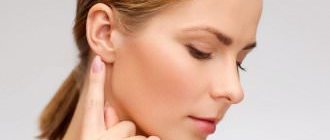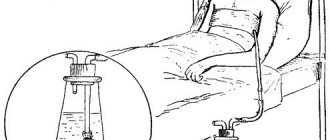Why does it hurt to tilt your head
The most common cause of this condition is overstrain of the neck muscles.
To do this, it is not necessary to carry weights, just stay in an uncomfortable position for a long time. Dozens of muscles belonging to the muscles of both the cervical region and the body are attached to the cervical vertebrae. They are divided into flexors and extensors and internal and external rotators. They are responsible for the fact that the neck hurts and it hurts to lower your head down, tilt it back or to the side.
These muscles act in pairs: when the flexor or internal rotator is tense, the extensor or external rotator is relaxed, and vice versa. Prolonged tension leads to the fact that the muscle is poorly supplied with oxygen and a spasm occurs. The muscle cannot relax; the blood flow in it must first be restored. Trying to force a spasmed muscle to work causes severe pain.
Many diseases can lead to similar symptoms. For example, the following diseases of the spine and surrounding tissues:
- osteochondrosis - dystrophy of spinal tissue, starting with the intervertebral disc and then spreading to surrounding tissues;
- spondylosis - the appearance of osteophytes (dense areas of tissue where they should not be);
- radiculitis - damage to the roots of the spinal nerves;
- myositis - inflammation of the neck muscles;
- osteoporosis - decreased density and increased fragility of bones, sometimes leading to spontaneous fractures, including cervical vertebrae;
- spinal canal stenosis - narrowing of the canal due to the growth of the surrounding cartilage and soft tissue;
- intervertebral hernia - rupture of the fibrous ring of the disc and protrusion of its nucleus, causing pain of a different nature or even paresis, depending on where exactly the rupture occurred;
- neoplasms (tumors) compressing nerve roots.
These are the most common diseases, due to which, when your neck hurts, it hurts to tilt your head forward, backward or to the side. The next reason is injuries. As a rule, the patient can accurately name the event that caused the pain. Most often, the neck is injured by sudden movements. As a result, the head tilts sharply towards the force acting on the person, and then, by inertia, leans back in the opposite direction. This is a whiplash injury. Its most likely result is a strain or, less commonly, a tear in the muscles or tendons involved in the movement.
A fracture or displacement of the vertebrae can also cause pain when changing the position of the head. Therefore, if severe pain occurs as a result of an injury or 2-3 days after it, you must definitely go to the emergency room.
Among diseases not associated with the cervical spine, characteristic symptoms can occur with migraine (like the head, the neck in this disease also bothers more often on one side), hypertension, sinusitis and sinusitis, inflammation of various nerves and nerve plexuses.
Causes of headaches with sudden movements
Pain may occur with sudden bending or turning of the head. This is due to pathologies of blood vessels, nerves, pressure changes and other reasons. Pain can also appear in a healthy person due to intense physical activity, stress and disruption of the sleep schedule. Most often, painful sensations go away after proper rest, but in some patients they indicate serious disorders that require treatment.
Migraine
Migraine is an acute headache that manifests itself without organic pathologies of blood vessels, brain and other organs. Doctors associate it with neurological disorders or vascular weakness. It has also been established that migraine is more often of hereditary origin and occurs simultaneously in several family members. It has a chronic course and manifests itself in the form of attacks, which can be caused by internal or external factors. Thus, migraines often occur against the background of climate change, stress, insomnia, and intense training.
The attack can last up to several days and consists of four phases:
- The prodromal period is a few days before the onset of headache. During this time, many patients experience weakness, dizziness, insomnia, as well as hearing and vision impairment. However, symptoms may be mild and unnoticeable.
- Aura is a neurological disorder that occurs immediately before or during the onset of a headache. An aura can include visual, auditory and movement (motor) disturbances, as well as combinations thereof. Characteristic symptoms are the appearance of dark circles in the field of vision, tinnitus, nausea and dizziness, and deterioration in coordination of movements. About 50% of migraine cases occur with aura; in other patients it is absent. (see Migraine with aura).
- The pain phase lasts no more than a few hours in children and 1–3 days in adults. The pain is sharp, severe, often spreading to the temples and the side of the head. It intensifies with any physical activity and sudden movements of the neck. During this phase, nausea and dizziness, weakness, and impaired consciousness and concentration may also be felt.
- Postdromal period - occurs when the headache goes away. A few days after the attack, you may feel worse. Patients experience weakness, gastrointestinal disorders, mood swings and other symptoms that disappear within 1–2 days, depending on the intensity of the attack.
Migraine often affects only half of the head, but can spread to its entire surface. The headaches are severe and worsen when turning and tilting the head, as well as with any sudden movements of the neck. Mild attacks can be relieved with painkillers, but for acute pain, the doctor will prescribe special medications against migraines.
Read more in the material: Chronic migraine
Hypertension
The blood pressure of a healthy person at rest is 120/80 mm. rt. Art. It is easy to measure at home using a tonometer. If the result is 130/90 mm. rt. Art. and more, we can talk about hypertension (high blood pressure). It is important that hypertension is physiological - blood pressure normally increases after exercise. To obtain accurate data, they were shown filming during rest.
Hypertension is a chronic disease that is manifested by increased blood pressure. It is most often diagnosed in middle and old age, but can also occur in young adults and children. Its causes are congenital disorders of pressure regulation mechanisms and acquired vascular diseases. During an attack, blood pressure increases sharply, which is accompanied by the following symptoms:
- throbbing headache, which intensifies when tilting and turning the head - it can spread to the temples, back of the head, frontal part;
- deterioration of vision, hearing, concentration;
- numbness of fingers and toes;
- swelling, redness of the skin of the face and mucous membranes;
- the appearance of small subcutaneous hematomas, especially in the face;
- arrhythmia, uneven and rapid pulse.
People who are overweight and those who lead a sedentary lifestyle are at risk. To treat hypertension, your doctor will select a special diet and prescribe medications to correct your blood pressure. They must be taken in a course to prevent another exacerbation.
Read more in the material: Headache with hypertension
Diseases of the cervical spine
The cervical region contains important vessels and nerves that lead to the brain. They are located in the protective canal formed by the openings between the vertebrae and on their lateral processes. In a healthy person, between the bone segments there are intervertebral discs - dense, elastic cartilaginous formations that absorb shock during movement. Their damage can be caused by various diseases, but leads to acute pain and affects general well-being.
- Cervical osteochondrosis is a chronic process of destruction of intervertebral discs. It can be caused by intense exercise, a sedentary lifestyle, or a disruption in the flow of blood to the cartilage. It leads to compression of the nerve roots and acute headaches, which intensify with neck movements. (see Headache with osteochondrosis of the cervical spine)
- Protrusion is a protrusion of cartilage beyond the spinal column. The process is accompanied by headaches and decreased neck mobility. In advanced cases, a hernia forms - the outer fibrous membrane ruptures, and the liquid contents (nucleus pulposus) leak out.
- Spinal curvature can be congenital or acquired. The process is often caused by incorrect posture and intense stress during the period of growth and formation of the spinal column.
To treat diseases of the cervical spine, the doctor will prescribe a comprehensive treatment regimen. It may include exercises to strengthen the neck muscles, massage and physiotherapy, as well as a course of medications. Painkillers and anti-inflammatory drugs, muscle relaxants, and warming ointments help with these diseases.
Vascular diseases
Atherosclerosis is one of the reasons why headaches occur during sudden movements. This is a chronic disease in which lipoproteins and cholesterol are deposited on the inner walls of the arteries. These deposits can form plaques, cause narrowing of the lumen of blood vessels and reduce the elasticity of their walls. This leads to a deterioration in blood flow to the brain and painful sensations. At the first signs of atherosclerosis, it is important to follow a low-fat diet, as well as take medications to remove excess cholesterol.
Read more in the material: Constriction of cerebral vessels
Diseases of the ENT organs
Headaches with sudden movements can also be caused by inflammation of the ears, mucous membrane of the nasopharynx or respiratory tract. Colds occur when a viral infection occurs and the body's immune defense is simultaneously reduced. It is important to get tested if the following symptoms worsen:
- fever for 3 days or more;
- the appearance of discharge from the nose or ear canals;
- weakness, headache;
- pain in the head area.
A characteristic symptom of sinusitis is a sharp headache when tilting the head down. If it is confirmed, the doctor will prescribe an additional x-ray examination. Treatment for most diseases of the ENT organs includes antibiotic therapy, lavage of the nasal passages, the use of ear drops and vasoconstrictors.
Other reasons
Headaches often appear due to stress, nervous tension, changes in atmospheric pressure and disturbances in sleep schedule. However, if they occur frequently, including after exercise, it is important to get tested. These symptoms may indicate the following disorders:
- brain tumors;
- neuritis - inflammation of the nerves that run in the neck and head;
- poisoning – associated with the intake of poisons and toxins from food, medicines, gaseous substances;
- stroke is one of the dangerous conditions that occurs when there is a sudden disruption of blood circulation in the brain; (See stroke)
- temporal arteritis is a specific disease in which inflammation of the temporal artery occurs;
- cluster pain is a rare type that is very severe. (see Cluster headaches)
Headaches are not a separate disease, but a symptom characteristic of many disorders. Doctors do not recommend enduring painful sensations. As first aid, you can take a pain reliever, but then it is important to undergo a full examination.
What may accompany neck pain
Pain in the neck when tilting the head forward, to the right, to the left or back is a symptom in itself, but sometimes it is accompanied by sensations that will help the doctor more accurately establish a preliminary diagnosis.
If your neck hurts when you tilt your head back, forward, left or right, and there is pain and numbness in the arm on the affected side, this indicates radicular syndrome or conditions associated with damage to the intervertebral discs. If it “shoots” in different parts of the body, and the pain is not relieved by prescribed medications, most often this is how inflammation of the nerves and neuritis manifests itself.
If the neck hurts when turning and bending, and the patient experiences dizziness, nausea, pain in the back of the head, there are likely problems with the spinal canal, vertebral displacement or subluxation, or intervertebral hernia.
An increase in body temperature that accompanies the main symptom may indicate myositis - severe inflammation of the muscle. If it is accompanied by vomiting, confusion, severe headaches, emergency help is needed: this may indicate inflammation not of soft tissues, but of the brain or spinal cord.
What does neck pain mean?
If there is pain in the neck when tilting the head, this may be a sign of muscle strain. This often occurs after a long stay in one position, for example, when sitting for a long time in front of a monitor screen or while driving a car. Intense physical activity, sports training, lifting and carrying heavy objects can cause this symptom.
Diseases of the muscular system or spine can also provoke pain. With prolonged muscle tension, a spasm occurs. Other provoking factors for this condition may be:
- Fibromyalgia is a chronic disease characterized by pain and hypersensitivity of muscles, tendons and joints;
- osteochondrosis – characterized by wear and tear of articular tissues, the joint may become displaced;
- osteoarthritis – characterized by wear and tear of cartilage tissue;
- autoimmune diseases that cause degenerative processes in bone tissue - rheumatoid or psoriatic arthritis, ankylosing spondylitis, polymyalgia;
- spinal stenosis;
- tuberculosis or osteomyelitis of the spine;
- thyroiditis – disease of the thyroid gland;
- lymphadenitis - an inflammatory process in the lymph nodes;
- polio – spinal cord paralysis;
- shingles;
- meningitis is an inflammatory process in the membranes of the spinal cord;
- diseases of the internal organs, in which pain radiates to the neck. These are pathological processes in the brain, heart, blood vessels, lungs, purulent processes in the body;
- spinal column or neck injuries;
- benign or malignant neoplasms or metastatic tissue lesions;
- previous surgical intervention on the spinal column.
For each of these diseases, additional symptoms must be present. Only a doctor can determine the presence of any pathological process in the body after a preliminary examination. You should not make a diagnosis or use medications yourself. To determine the cause of the pain, additional diagnostics are needed.
How to make a diagnosis
To establish a diagnosis, you first need an in-person examination by a doctor. To begin with, a therapist who will figure out whether the pain is associated with the cervical spine or has other causes. The exception is if you get sick after an injury. Then it is necessary to visit a traumatologist, since emergency rooms have equipment that allows you to quickly determine whether there is a threat to the patient’s health.
If there was no injury, and the therapist found out that the pain is directly related to the tissues of the neck, an x-ray will be prescribed in two projections. In cases where the image results are insufficient, magnetic resonance imaging (MRI) is prescribed. The study allows us to identify the condition of soft tissues: changes inside the spinal canal, neoplasms at the nerve roots, inflammation of muscles and ligaments. Ultrasound of the ligaments is rarely prescribed in such cases, blood tests are almost never prescribed.
With the results of the studies, patients are referred for consultation to a neurologist or, less commonly, a vertebrologist. If signs of diseases are found in which the neck lesion is secondary, the therapist will refer the patient to other specialists.
How to cure without harming
The standard of treatment for neck pain is the same as for other areas of the spine. These are non-steroidal anti-inflammatory drugs, with the help of which pain is reduced and inflammation is partially stopped, and physiotherapy, aimed at improving blood circulation in the diseased area or delivering medications to it. B vitamins are often added to the course, as well as medications that relax muscles. In most cases, this set of medications is enough to relieve pain.
The abundance of causes of cervicalgia, including those associated with head movements, means that standard therapy does not always help. Therefore, self-medication or treatment without examination is unacceptable. At the first appointment, the doctor may prescribe medications to alleviate the patient’s condition, but diagnostic procedures must also be recommended along with them.
If it turns out that the cause can be eliminated completely, then the treatment is changed. But it happens that the cause is a chronic disease, or it cannot be determined at all during examinations. In such cases, manual therapy can help.
It is impossible to resort to manual therapy before a full examination of the condition of the spine. This method of treatment involves serious impact on muscles and joints, and in some situations can be harmful.
Treatment of noise in the head with cervical osteochondrosis
Without eliminating the underlying disease, it is impossible to get rid of noise in the head. But osteochondrosis is a chronic progressive pathology that is problematic to cure, especially if the pathological process has been going on for several years and is in an advanced stage.
Note! Only the initial stages of cervical osteochondrosis are treated. In other cases, treatment is aimed at inhibiting degenerative processes.
To reduce the manifestations of osteochondrosis, complex therapy is required, which includes:
- use of medications;
- physiotherapeutic procedures;
- massage;
- therapeutic exercises;
- wearing orthopedic devices (Schants collar).
In case of displacement of the vertebrae, formation of osteophytes, hernias, or severe narrowing of the lumen of the spinal column, surgery is performed. All defects that cannot be removed conservatively are removed surgically.
Drug therapy
To treat noise in the head, the following groups of drugs are used:
- analgesics;
- muscle relaxants;
- non-steroidal anti-inflammatory drugs;
- corticosteroids;
- chondroprotectors;
- vitamin and mineral complexes;
- sedatives;
- diuretics, decongestants;
- medications to improve cerebral circulation (some of them are contraindicated for low blood pressure);
- antihypertensive drugs;
- nootropics.
The course of drug treatment for noise in the head with cervical osteochondrosis can last several months, depending on the severity of the patient. Throughout the entire therapy, the neurologist monitors the patient’s condition and adjusts the treatment regimen.
Physiotherapeutic procedures
To reduce muscle spasm and tension, the following procedures are used:
- magnetic therapy;
- laser therapy;
- UHF;
- electrical stimulation;
- phonophoresis;
- electrophoresis;
- mud therapy.
To reduce noise in the head, manual techniques, acupuncture, and underwater traction are used.
Kazieva Aminat Ziyavovna
Neurologist
Rostov State Medical University
Experience since 2012
Note! All physiotherapeutic procedures are carried out strictly according to indications, according to the schedule.
Massage
It is an obligatory part of the treatment of headaches and noise in the head due to osteochondrosis, but there are contraindications to massage:
- severe pain syndrome;
- severe compression of the nerve roots;
- hypertonicity of the muscles of the cervical-collar area;
- acute inflammatory process;
- hypertension;
- thrombosis;
- aneurysm;
- oncological diseases.
Massage relaxes muscles, improves blood circulation and reduces neurological symptoms. It is performed by a physical therapist or chiropractor. Treatment must be combined with neck exercises.
Note! Some therapeutic massage techniques are available only to qualified specialists, so they cannot be repeated at home.
Physiotherapy
The first training sessions should take place with an instructor, since exercises are selected individually for each patient. They help strengthen muscles, eliminate tension and normalize blood circulation.
Gymnastics is also a mandatory preventive measure for the occurrence of symptoms of cervical osteochondrosis. A set of exercises should be performed daily, 3-4 times a day. When working at a computer, warm-up is required every 1.5-2 hours.
Note! For osteochondrosis in the cervical spine, swimming and water aerobics are useful. Water relieves the spine, and physical activity helps strengthen the muscle frame.
Life hacks for neck pain
The best way to avoid pain in the back, front or side of the neck when tilting your head is just bending and turning. Periodic warm-up during the day - and painful sensations begin to bother the patient much less often. The main thing is not to do exercises through pain. It may be unpleasant, and a pulling sensation may appear. This means that for now this range of motion is sufficient, but the exercises must be continued. But when a person cannot tilt his head to the left or right because his neck hurts, physical education must be interrupted and seek help.
To prevent the pain of throwing your head back and to relieve the pain in your neck, you need to take a closer look at your workplace and the bed. The mattress and pillow must be orthopedic, the degree of their hardness will be recommended by the doctor. The workplace should place minimal stress on the spine and muscles. When working at a computer, the feet, legs, hips, body, shoulders and elbows should be at right angles to each other, and the monitor and keyboard should be directly in front of the user, so that you do not have to turn your head or body to work, much less hold them in this position all day.
If a person often cannot tilt his head to the left or right because his neck hurts, you need to pay attention to windows, fans, or the patient’s behavior in the car. A strong directional flow of cold air may well cause such troubles. You can’t simply inflate from a window so that severe pain occurs. But a poorly adjusted air conditioner or air flow from a window crack when the car is moving can do this. This reason is the easiest to eliminate: you need to slightly change your habits or adjust the air conditioner curtain so that the flow of cold air flows parallel to the ceiling.
In what case should you see a doctor immediately?
It is not always necessary to consult a doctor if you experience the slightest discomfort or pain. If a spasm occurs in the muscle system, which is caused by overexertion, such symptoms disappear on their own within a week. In this case, you need to take an analgesic and perform simple exercises.
You need to sound the alarm if the pain persists for 2 weeks or if additional unpleasant symptoms occur:
- numbness, tingling in the upper extremities;
- limited mobility of the neck and arms;
- curvature of the neck;
- sharp and prolonged attacks of migraines;
- dizziness and loss of consciousness;
- sudden jumps in blood pressure;
- dyspnea;
- chest pain;
- attacks of nausea and vomiting;
- swallowing dysfunction;
- elevated body temperature.
If such symptoms appear, it is not recommended to make any diagnoses or start using medications. It is important to pay attention to whether there is swelling in the neck and what size the lymph nodes are. In this case, doctors prescribe a detailed diagnosis that will help establish the correct diagnosis. You will need to undergo the following types of examinations:
- radiography;
- CT scan;
- Magnetic resonance imaging;
- laboratory examination of blood fluid;
- electromyography;
- spinal tap;
- electrocardiography.
Depending on the diagnosis, the doctor selects the most appropriate treatment.










